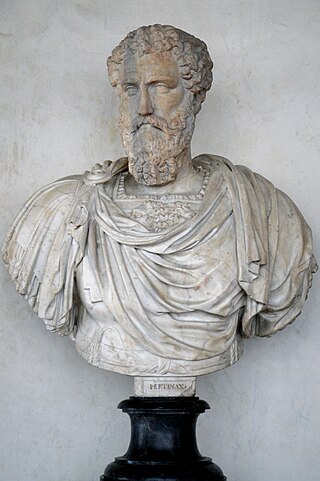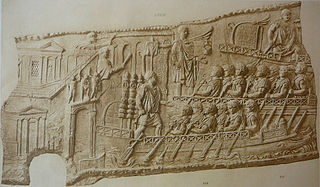 |
| Part of a series on the |
| Military of ancient Rome |
|---|
The evocati augusti were soldiers of the Praetorian Guard who had obtained an honorable discharge after serving for their time and chose to re-enlist.
 |
| Part of a series on the |
| Military of ancient Rome |
|---|
The evocati augusti were soldiers of the Praetorian Guard who had obtained an honorable discharge after serving for their time and chose to re-enlist.
Due to being evocati , soldiers who had re-enlisted after serving their 16 years, of the Praetorian Guard, they were the only evocati allowed to use the adjective of "imperial" (augusti). [1] Unlike the regular evocati, it appears that evocati augusti were hand-picked by the Emperor, rather than it being open for all. [2] Many evocati augusti went on to be centurions in the regular legions, and beyond. [3]
| | This section is empty. You can help by adding to it. (March 2018) |

The Severan dynasty, sometimes called the Septimian dynasty, was an Ancient Roman imperial dynasty that ruled the Roman Empire between 193 and 235, during the Roman imperial period. The dynasty was founded by the emperor Septimius Severus, who rose to power after the Year of the Five Emperors as the victor of the civil war of 193–197, and his wife, Julia Domna. After the short reigns and assassinations of their two sons, Caracalla and Geta, who succeeded their father in the government of the empire, Julia Domna's relatives themselves assumed power by raising Elagabalus and then Severus Alexander to the imperial office.

Publius Helvius Pertinax was Roman emperor for the first three months of 193. He succeeded Commodus to become the first emperor during the tumultuous Year of the Five Emperors.

The Praetorian Guard was an elite unit of the Imperial Roman army that served as personal bodyguards and intelligence agents for the Roman emperors.
A cohort was a standard tactical military unit of a Roman legion. Although the standard size changed with time and situation, it was generally composed of 480 soldiers. A cohort is considered to be the equivalent of a modern military battalion. The cohort replaced the maniple. From the late second century BC and until the middle of the third century AD, ten cohorts made up a legion. Cohorts were named "first cohort", "second cohort", etc. The first cohort consisted of experienced legionaries, while the legionaries in the tenth cohort were less experienced.
The praetorian prefect was a high office in the Roman Empire. Originating as the commander of the Praetorian Guard, the office gradually acquired extensive legal and administrative functions, with its holders becoming the Emperor's chief aides. Under Constantine I, the office was much reduced in power and transformed into a purely civilian administrative post, while under his successors, territorially-defined praetorian prefectures emerged as the highest-level administrative division of the Empire. The prefects again functioned as the chief ministers of the state, with many laws addressed to them by name. In this role, praetorian prefects continued to be appointed by the Eastern Roman Empire until the reign of Heraclius in the 7th century AD, when wide-ranging reforms reduced their power and converted them to mere overseers of provincial administration. The last traces of the prefecture disappeared in the Byzantine Empire by the 840s.

The Dominate, also known as the late Roman Empire, is the despotic form of imperial government of the late Roman Empire. It followed the earlier period known as the Principate. Until the empire was reunited in 313, this phase is more often called the Tetrarchy.
A vexillatio was a detachment of a Roman legion formed as a temporary task force created by the Roman army of the Principate. It was named from the standard carried by legionary detachments, the vexillum, which bore the emblem and name of the parent legion.
The speculatores, also known as the speculatores augusti or the exploratores, were an ancient Roman reconnaissance agency. They were part of the consularis and were used by the Roman military. The speculatores were headquartered in the Castra Peregrina.

An evocatus was a soldier in the Ancient Roman army who had served out his time and obtained an honorable discharge but had voluntarily enlisted again at the invitation of the consul or other commander.

The Scholae Palatinae were an elite military imperial guard unit, usually ascribed to the Roman Emperor Constantine the Great as a replacement for the equites singulares Augusti, the cavalry arm of the Praetorian Guard. The Scholae survived in Roman and later Byzantine service until they disappeared from the historical record in the late 11th century, during the reign of Alexios I Komnenos.

Castra Praetoria were the ancient barracks (castra) of the Praetorian Guard of Imperial Rome.
Protector Augusti Nostri was a title given to individual officers of the Roman army as a mark of their devotion to and approval by the Emperor himself. The term first appears with this meaning in the joint-reign of Valerian and Gallienus. Lucius Petronius Taurus Volusianus was the first recorded Protector appointed by Gallienus.

Tiberius Claudius Maximus was a cavalryman in the Imperial Roman army who served in the Roman legions and Auxilia under the emperors Domitian and Trajan in the period AD 85–117. He is noted for presenting Trajan with the head of Dacian king Decebalus, who had committed suicide after being surrounded by Roman cavalry at the end of Dacian Wars.

The constitution of the late Roman Empire was an unwritten set of guidelines and principles passed down, mainly through precedent, which defined the manner in which the late Roman Empire was governed. As a matter of historical convention, the late Roman Empire emerged from the Roman Principate, with the accession of Diocletian in AD 284, his reign marking the beginning of the Tetrarchy. The constitution of the Dominate outrightly recognized monarchy as the true source of power, and thus ended the facade of dyarchy, in which emperor and Senate governed the empire together.

The equites singulares Augusti were the cavalry arm of the Praetorian Guard during the Principate period of imperial Rome. Based in Rome, they escorted the Roman emperor whenever he left the city on a campaign or on tours of the provinces. The equites singulares Augusti were a highly trained unit dedicated to protecting the emperor. Men who served in the equites singulares Augusti held a Roman public status as equites.

The Numerus Batavorum, also called the cohors Germanorum, Germani corporis custodes, Germani corpore custodes, Imperial German Bodyguard or Germanic bodyguard was a personal, imperial guards unit for the Roman emperors of the Julio-Claudian dynasty composed of Germanic soldiers. Although the Praetorians may be considered the Roman Emperor's main bodyguard, the Germanic bodyguards were a unit of more personal guards recruited from distant parts of the Empire, so they had no political or personal connections with Rome or the provinces.
The aerarium militare was the military treasury of Imperial Rome. It was instituted by Augustus, the first Roman emperor, as a "permanent revenue source" for pensions (praemia) for veterans of the Imperial Roman army. The treasury derived its funding from new taxes, an inheritance tax and a sales tax, and regularized the ad hoc provisions for veterans that under the Republic often had involved socially disruptive confiscation of property.
By the size of the Roman army is meant the changes in the number of its contingents: legions, auxiliaries, Praetorian cohorts, Urban cohorts, vigiles, and naval forces over the course of twelve centuries – from 753 BC to AD 476.

Classiarii referred to all military personnel and personnel assigned to the maneuvering of ships or their construction/maintenance, as part of the Roman navy, an integral part of the Roman army.